-
Engine6.3L V12
-
Power680 HP / 514 LB-FT
-
Transmission7-Speed Dual-Clutch
-
Top Speed208 MPH
-
DrivetrainAll-Wheel Drive
-
Engine PlacementFront
-
Seating2+2
-
Base Price$300,000 (est)
The Ferrari FF is a monster, a four-wheel-drive bread van with a 6.3-liter V12 that people like us have adored since it arrived in 2011. It's great to drive and better to look at, a shooting brake with more power, less practicality, and a higher price tag than pretty much anything else in this shape. Ferrari has sold almost 6,000 of them, handily beating its target of 800 per year. It was a success by any measure.
Its replacement, the GTC4Lusso, might sound like something out of Ferrari's mad, bad Sixties brochures, but under the skin is pretty much the same aluminum-alloy space frame of the FF. Ferrari has carefully listened to its critics on practicality, price, and power, and duly made the GTC more powerful, pricier, and not much more practical.
There have been some slight stylistic adjustments. A scallop was cut into the front fender and door skins to reduce the visual weight, and the roofline has been extended, terminating in a slight spoiler at the waist, which is said to improve aerodynamic efficiency by up to six percent. It looks sharp and mean on its 20-inch five-spoke alloys, although some of the detail, such as the wing vents and the absurdly long hood, verge on the cartoonish.
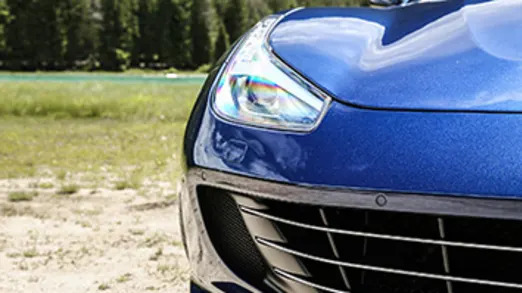
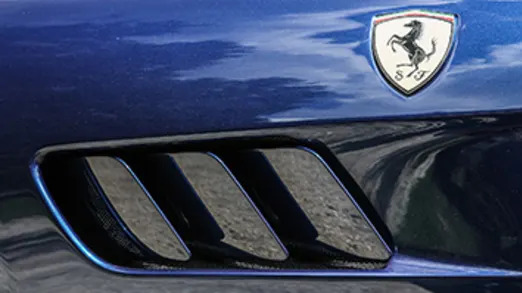
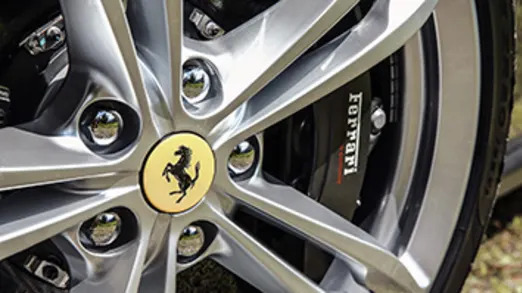

The basic 65-degree, 6.3-liter, quad-cam V12 stays largely the same, but has a higher compression ratio and redesigned cylinder heads and pistons, which make the fuel/air mix burn more efficiently and consequently provides 30 more horsepower. The engine shrieks to 8,250 rpm, but peak power is 681 hp at 8,000 rpm with peak torque of 514 pound-feet produced at 5,750 rpm. Top speed remains the same at 208 mph, but the 0–62 mph acceleration time comes down slightly to 3.4 seconds. US gas mileage is yet to be homologated, but the European-cycle figures improve slightly – not that you care.
The engine drives a rear-mounted, seven-speed, twin-clutch transaxle and then there is that extraordinary four-wheel-drive system, which consists of a simple, helical-cut, hydraulically controlled gearbox running off the front of the crankshaft. It weighs 100 pounds and has two speeds plus reverse and a couple of Haldex-type clutches to activate each wheel when required in first to fourth gears and at speeds below 124 mph. New for the GTC is a ZF rear-steering system, a ram powered by an electric motor that pushes the rear suspension against its bushings to give a couple of degrees steering in either direction. Driving these systems, together with the F1 electronic rear differential, electronic stability system, magnetorheological adjustable dampers, and the torque vectoring, is handled by Ferrari's fourth-generation side-slip-control system. It's a mighty task of calibration and we'll come back to this, but the system is designed to improve the car's stability and agility from fast to slow speeds on bone dry or icy road surfaces. Ferrari claims a five percent improvement in responsiveness (the reduction in steering delay) and an eight percent improvement in agility (the reduction in steering response).

The cabin is gorgeously appointed in soft leather with gentle curves and spine-friendly seats. Trunk space remains the same at 15.9 cubic feet, with up to 28.3 cubic feet available with the rear seatbacks folded. Thanks to heavily scalloped front seats, there is now a tad more leg room in the rear. It means a couple of large adults can sit in some comfort for up to an hour at least. And if you are intent on going shooting with your Ferrari, you'll get the guns and ammo in there, but not the Labradors.
The dashboard is deceptively simple, with complicated air vents and a button-festooned steering wheel complete with fixed gear-shift paddles. The massive central touch screen has manual control panels hung incongruously off the bottom. As in other Ferraris, the front-seat passenger gets his or her own optional screen to play with displays including duplicated navigation instructions, gauges displaying speed and g-forces, and in-car entertainment controls. The sparse design means that each of the switches has a lot to do and there were complaints that the steering wheel controls were over complicated on the launch. Most buyers are choosing a Ferrari for a different type of entertainment, though.
The engine whoops into life at the touch of the steering-wheel button, and then you click the right-hand paddle to engage first gear. At 193.8 inches long and 77.9 inches wide, this isn't an easy car to maneuver, and views out the back aren't good – parking sensors are essential. The exhaust valves have been reworked to improve the noisy urban manners of the FF, which helps some, and with so much torque the engine barely needs to raise its needle above idle to get moving. Actually around town this is a pussycat, with a long-travel throttle and gentle responses in Comfort mode. The ride is good and there's enough ground clearance to clear a Detroit or San Francisco drive without scraping the bottom.

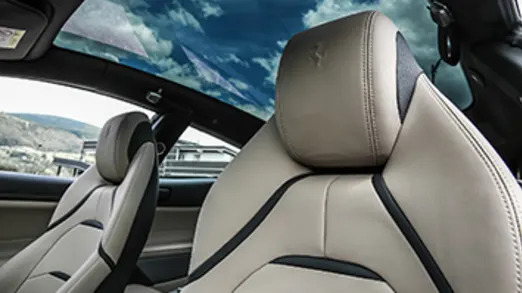
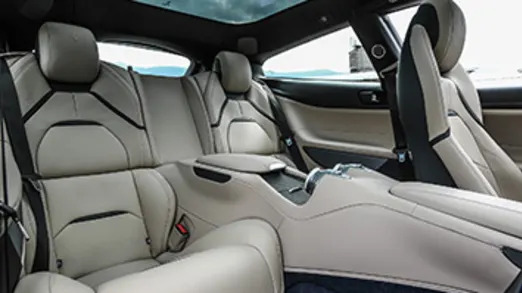
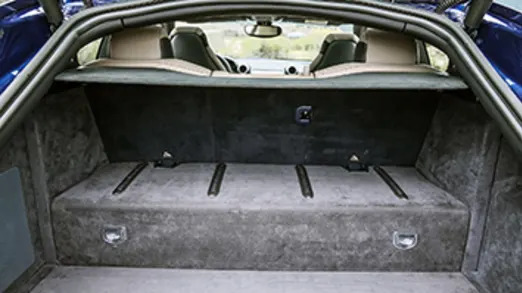
Go a little faster and the ride remains supple, although there is a slight lumpiness from the rear end. The steering isn't as twitchy as in Ferrari's mid-engined models, with a degree or two of free play in the dead-ahead position. The brakes, too, have a long-travel pedal, which needs learning. Turn-in is a little abrupt at first as the rear-drive systems ease the nose into the corner, but you do get used to it. At medium speeds the GTC feels like a classy GT; agile, speedy, and spacious although the driveline feels inert with little feedback. Sound suppression is good, too, but despite Ferrari's claims to have made improvements, the air conditioning still makes a racket on higher levels of boost. Again, not why you choose a Ferrari.
The engine is completely brilliant, providing a growl, gurgles at medium speeds, and a series of whirring yelps as the revs rise towards the redline. This isn't a fast car in the manner of its turbo rivals, but the way it gathers speed is astonishing and not a little unnerving, and the throttle response is almost instant.
And then you stand on it. At that point, the performance goes from brisk to thunderbolt-fast, and in Sport mode the transmission shifts gears with alacrity and the suspension feels harder, but it still rides the bumps. At over two tons (a claimed 4,233 pounds with optional equipment), this car is a serious performer, and fortunately the brakes are powerful and confidence inspiring.

Not so good, however, is what's happening to the handling. On South Tyrol's grippy roads, you can feel the rear steering and front wheels forcing the car into the turns. But the chassis responses are complicated by the rear steering, which adds an abrupt, twitching quality to tighter corner entry. You learn to be gentle with the steering, but what can't be learned or driven around is the extraordinary leaping and hopping that goes on when the Side Slip Control thinks the back is going to go wide. Piling on opposite lock only complicates matters, so the rear wheels steer one way and another as you add and take away lock.
This rear steering issue isn't Ferrari's alone, but if it's not adding anything, then why is it there? True, the system might work at slower speeds and on slippery surfaces, but if it can't do the faster stuff, then it feels as if Ferrari has developed an SUV driveline for a high-performance shooting brake and hasn't Fiat Chrysler Automobiles boss Sergio Marchionne made it clear that Ferrari will not build an SUV?
I wanted to love the GTC and Ferrari deserves all its plaudits for producing such a terrific looking shooting brake where rivals have shied away. Fact is, however, that while the GTC is probably more stable and agile on slippery roads, when you are pushing things, it simply doesn't steer or corner as well as its predecessor. So admiration and respect where due, but less love this time.
Related Video:

Its replacement, the GTC4Lusso, might sound like something out of Ferrari's mad, bad Sixties brochures, but under the skin is pretty much the same aluminum-alloy space frame of the FF. Ferrari has carefully listened to its critics on practicality, price, and power, and duly made the GTC more powerful, pricier, and not much more practical.
There have been some slight stylistic adjustments. A scallop was cut into the front fender and door skins to reduce the visual weight, and the roofline has been extended, terminating in a slight spoiler at the waist, which is said to improve aerodynamic efficiency by up to six percent. It looks sharp and mean on its 20-inch five-spoke alloys, although some of the detail, such as the wing vents and the absurdly long hood, verge on the cartoonish.




The basic 65-degree, 6.3-liter, quad-cam V12 stays largely the same, but has a higher compression ratio and redesigned cylinder heads and pistons, which make the fuel/air mix burn more efficiently and consequently provides 30 more horsepower. The engine shrieks to 8,250 rpm, but peak power is 681 hp at 8,000 rpm with peak torque of 514 pound-feet produced at 5,750 rpm. Top speed remains the same at 208 mph, but the 0–62 mph acceleration time comes down slightly to 3.4 seconds. US gas mileage is yet to be homologated, but the European-cycle figures improve slightly – not that you care.
The engine drives a rear-mounted, seven-speed, twin-clutch transaxle and then there is that extraordinary four-wheel-drive system, which consists of a simple, helical-cut, hydraulically controlled gearbox running off the front of the crankshaft. It weighs 100 pounds and has two speeds plus reverse and a couple of Haldex-type clutches to activate each wheel when required in first to fourth gears and at speeds below 124 mph. New for the GTC is a ZF rear-steering system, a ram powered by an electric motor that pushes the rear suspension against its bushings to give a couple of degrees steering in either direction. Driving these systems, together with the F1 electronic rear differential, electronic stability system, magnetorheological adjustable dampers, and the torque vectoring, is handled by Ferrari's fourth-generation side-slip-control system. It's a mighty task of calibration and we'll come back to this, but the system is designed to improve the car's stability and agility from fast to slow speeds on bone dry or icy road surfaces. Ferrari claims a five percent improvement in responsiveness (the reduction in steering delay) and an eight percent improvement in agility (the reduction in steering response).

The cabin is gorgeously appointed in soft leather with gentle curves and spine-friendly seats. Trunk space remains the same at 15.9 cubic feet, with up to 28.3 cubic feet available with the rear seatbacks folded. Thanks to heavily scalloped front seats, there is now a tad more leg room in the rear. It means a couple of large adults can sit in some comfort for up to an hour at least. And if you are intent on going shooting with your Ferrari, you'll get the guns and ammo in there, but not the Labradors.
The dashboard is deceptively simple, with complicated air vents and a button-festooned steering wheel complete with fixed gear-shift paddles. The massive central touch screen has manual control panels hung incongruously off the bottom. As in other Ferraris, the front-seat passenger gets his or her own optional screen to play with displays including duplicated navigation instructions, gauges displaying speed and g-forces, and in-car entertainment controls. The sparse design means that each of the switches has a lot to do and there were complaints that the steering wheel controls were over complicated on the launch. Most buyers are choosing a Ferrari for a different type of entertainment, though.
The engine whoops into life at the touch of the steering-wheel button, and then you click the right-hand paddle to engage first gear. At 193.8 inches long and 77.9 inches wide, this isn't an easy car to maneuver, and views out the back aren't good – parking sensors are essential. The exhaust valves have been reworked to improve the noisy urban manners of the FF, which helps some, and with so much torque the engine barely needs to raise its needle above idle to get moving. Actually around town this is a pussycat, with a long-travel throttle and gentle responses in Comfort mode. The ride is good and there's enough ground clearance to clear a Detroit or San Francisco drive without scraping the bottom.




Go a little faster and the ride remains supple, although there is a slight lumpiness from the rear end. The steering isn't as twitchy as in Ferrari's mid-engined models, with a degree or two of free play in the dead-ahead position. The brakes, too, have a long-travel pedal, which needs learning. Turn-in is a little abrupt at first as the rear-drive systems ease the nose into the corner, but you do get used to it. At medium speeds the GTC feels like a classy GT; agile, speedy, and spacious although the driveline feels inert with little feedback. Sound suppression is good, too, but despite Ferrari's claims to have made improvements, the air conditioning still makes a racket on higher levels of boost. Again, not why you choose a Ferrari.
The engine is completely brilliant, providing a growl, gurgles at medium speeds, and a series of whirring yelps as the revs rise towards the redline. This isn't a fast car in the manner of its turbo rivals, but the way it gathers speed is astonishing and not a little unnerving, and the throttle response is almost instant.
And then you stand on it. At that point, the performance goes from brisk to thunderbolt-fast, and in Sport mode the transmission shifts gears with alacrity and the suspension feels harder, but it still rides the bumps. At over two tons (a claimed 4,233 pounds with optional equipment), this car is a serious performer, and fortunately the brakes are powerful and confidence inspiring.

Not so good, however, is what's happening to the handling. On South Tyrol's grippy roads, you can feel the rear steering and front wheels forcing the car into the turns. But the chassis responses are complicated by the rear steering, which adds an abrupt, twitching quality to tighter corner entry. You learn to be gentle with the steering, but what can't be learned or driven around is the extraordinary leaping and hopping that goes on when the Side Slip Control thinks the back is going to go wide. Piling on opposite lock only complicates matters, so the rear wheels steer one way and another as you add and take away lock.
This rear steering issue isn't Ferrari's alone, but if it's not adding anything, then why is it there? True, the system might work at slower speeds and on slippery surfaces, but if it can't do the faster stuff, then it feels as if Ferrari has developed an SUV driveline for a high-performance shooting brake and hasn't Fiat Chrysler Automobiles boss Sergio Marchionne made it clear that Ferrari will not build an SUV?
I wanted to love the GTC and Ferrari deserves all its plaudits for producing such a terrific looking shooting brake where rivals have shied away. Fact is, however, that while the GTC is probably more stable and agile on slippery roads, when you are pushing things, it simply doesn't steer or corner as well as its predecessor. So admiration and respect where due, but less love this time.
Related Video:

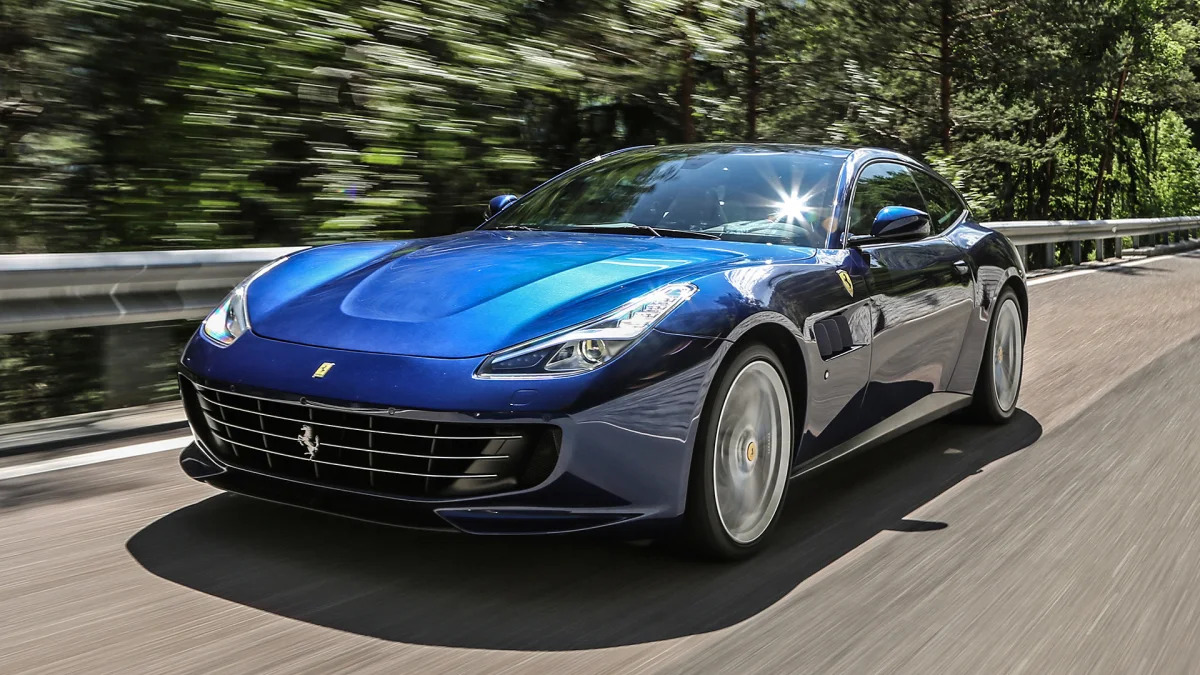









Sign in to post
Please sign in to leave a comment.
Continue